Spending time outside with your four-legged friend can involve so much more than a walk in the park. Our friends at Ruffwear talk us through different types of dog-friendly adventures and offer their expertise to help you have a great day out with your dog.
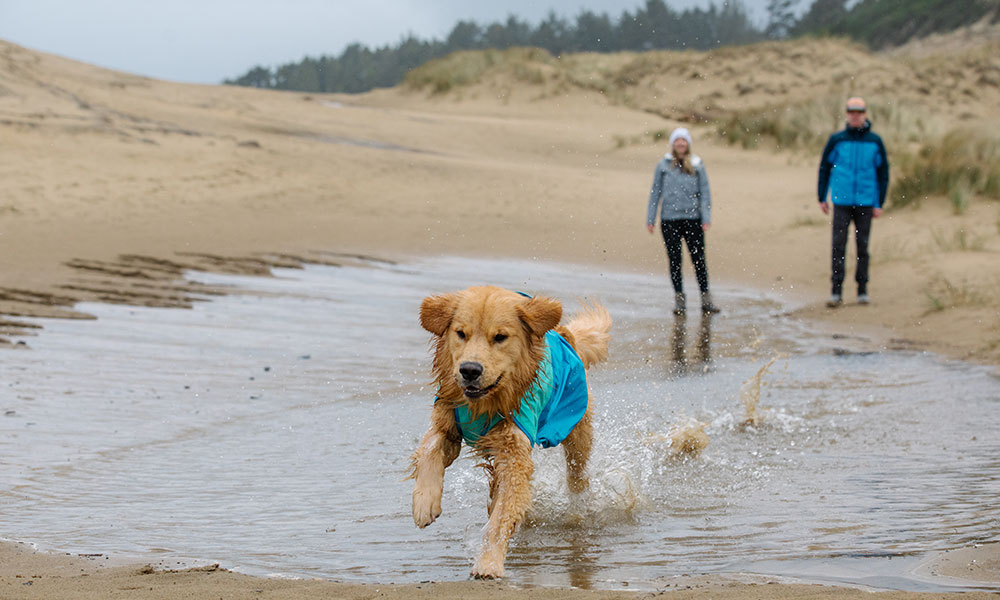
Photo: @Ruffwear
Hiking
Extend your local dog walk by venturing further afield and hitting the trails. Your dog has evolved over millennia to cover huge distances across the wild – just like you. So, there’s no reason your dog can’t accompany you on a longer hike such as the Pennine Way.
When introducing your dog to any activity it’s best to build up their endurance. Start slowly, especially when introducing rough and steep terrain, and allow plenty of time for rest stops. Even if your dog is used to long hikes a change in the weather can make it harder, and even dangerous in very hot or very cold conditions. If your dog is more used to smooth pavements than rocky paths it can take time to toughen up their paws. Dog boots are a great option to protect paws from rough terrain and extremes of temperatures. It’s worth giving your dog a check over for ticks and other pests when you get home.
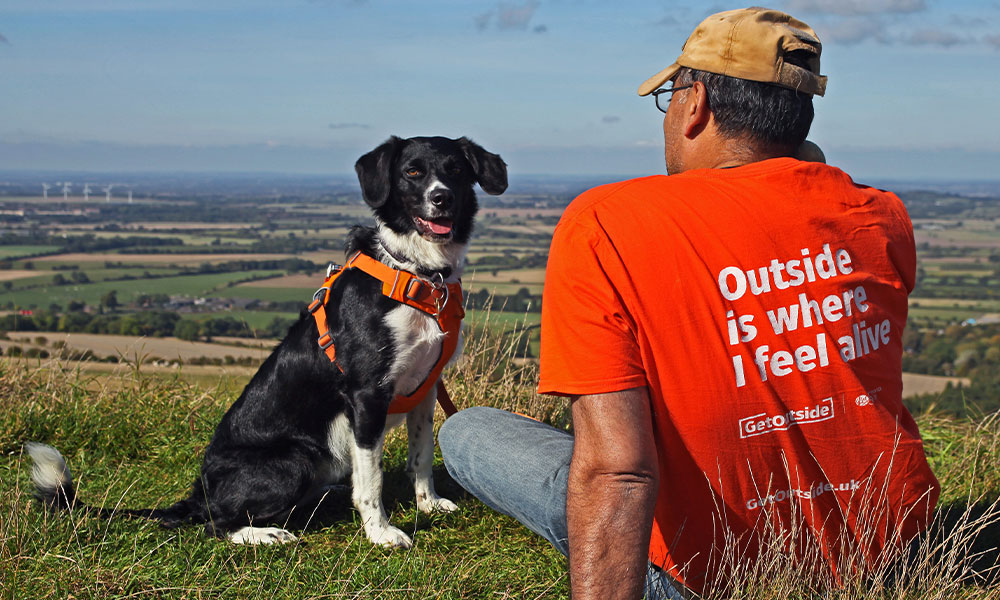
Some routes will require your dog to be on a lead at all times, others may have seasonal rules to protect livestock and wildlife such as ground nesting birds. Your dog should always be within eye and ear shot and you should always leave no trace when out and about. If you are planning to let your dog explore off leash you should make sure they respond to key commands, especially when it comes to recall.
After a day hiking, there’s nothing better than a well-earned visit to a county pub! Most happily welcome dogs but it’s best to check first.

What to carry
For longer hikes you’ll need dog food, plenty of water, a collapsible water bowl (so you don’t have to share!), a short leash and poop bags. Optional extras include: dog boots and liners, dog pack, safety light and a towel for muddy paws.
Camping
Our four-legged friends make the perfect camping companion and once you have a plan, camping with your dog is relatively hassle-free. Our dog’s basic needs are not too different than our own: food, water, warmth, a place to rest, and first aid supplies.
At camp, keep your four-legged friend on leash and within your control. Trying to keep an eye on a roaming dog while setting up camp, building a campfire, or eating dinner can be tricky! If your camping buddy has a lot to say or loves to let out a good howl at the moon, consider camping at a more secluded location. What’s music to our ears might be less than ideal for other’s wilderness experience. When in doubt, err on the side of courtesy.
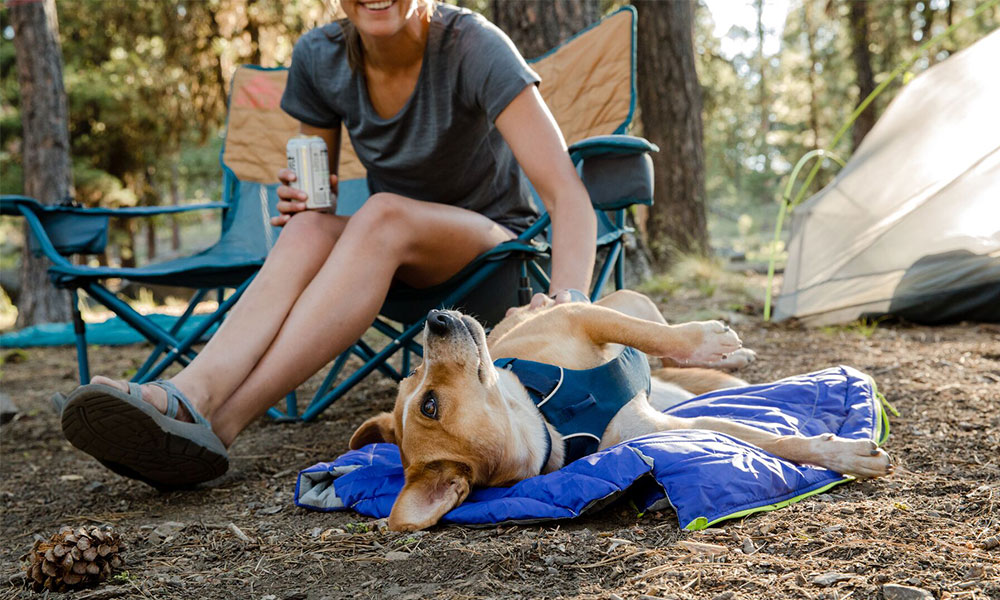
Photo: @Ruffwear
Taking your dog camping for the first time is exciting, but it might feel a little daunting. Do your best to prepare ahead of time and have a back-up plan. Beyond that, a little patience and sense of humour will help. Not all dogs take to sleeping in a tent (or going in and out of tent doors) right away, but with practice, they will get the hang of it.

Get some well-earned rest
If you’re serious about sleeping, create a space for your dog in your tent’s porch and not inside. Doggie sleeping bags ensure a great night sleep.
Mountain Biking
The most important tip of all is to slowly get your dog used to longer rides, faster paces, and longer, fast down hill stretches of trails. Like with hiking, allow your dog’s paws to toughen up by starting out on semi-smooth dirt tracks before working your way up to rougher and rockier terrain. Keeping up with a bike is hard work so ensure your dog has enough water. Every time you are thirsty and take a drink your dog probably is too. For dogs that are active, diets high in good quality fats are key. Feed your dog after the activity as feeding before running can cause diarrhoea and is rough on their digestion.
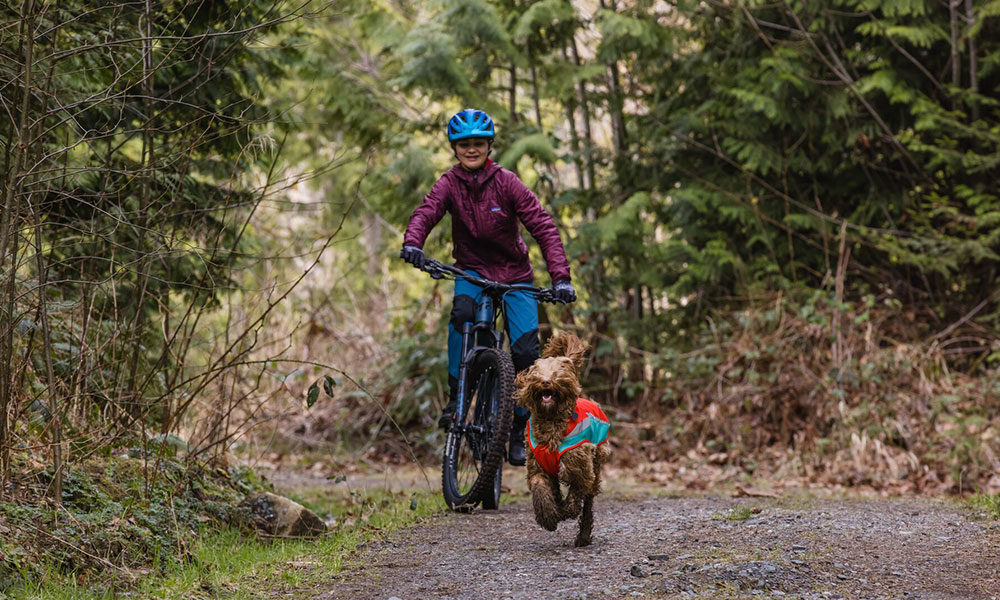
Photo: @Ruffwear
Some dogs aren’t sure how to behave around bike or may have forgotten, so teach your dogs the do’s and don’ts before heading out on a bigger bike adventure. Try to teach your pooch to stay behind the bike at all times. This protects them from downhill traffic and protects other riders from potential crashes out of trying to avoid a dog in the middle of the path. Slowly riding with your dog leashed, and correcting along the way is the easiest way to do this.

A simple command
When other people approach, a simple command, “off the trail” can be used so your dog knows that it’s time to get off the path and them pass.
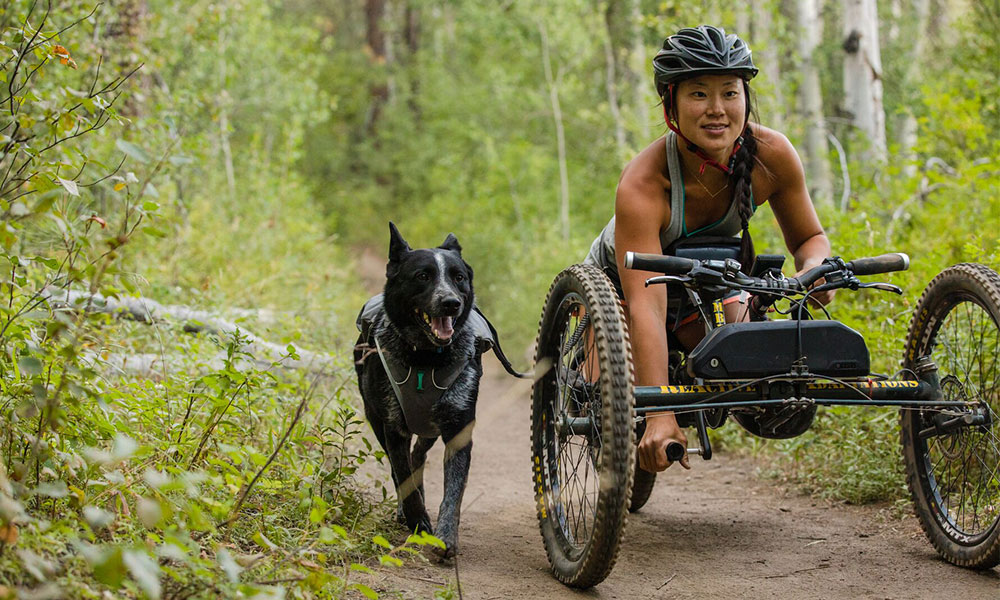
Photo: @Ruffwear
Swimming
Swimming in nature is invigorating, re-energising and one of the most popular ways to reconnect with the great outdoors. Dogs also love a paddle so why not take your dog to your nearest beach, lake or river (where swimming is permitted) and enjoy a friendly splash. Choose your swimming spot wisely and make sure you’re not getting in anyone’s way.
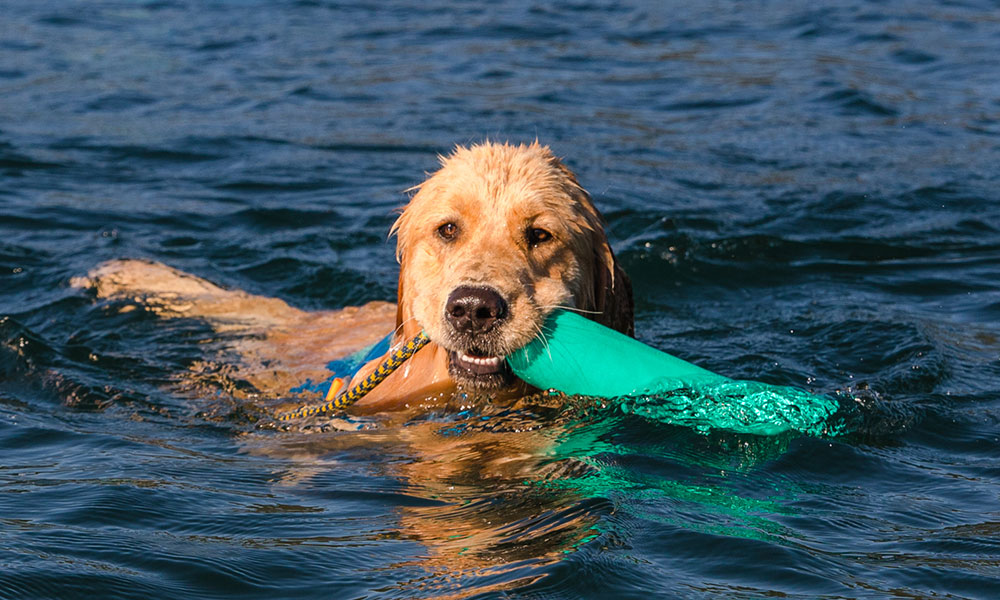
Photo: @Ruffwear
Some dogs can be water-shy so start them off with a paddle before taking them for a full dip. If your dog is less-confident in the water, swim where it is shallow and without a current. Some dogs can be water-shy so start them off with a paddle before taking them for a full dip. It may also be worth investing in a doggie life-jacket to keep them safe. Finally, be careful not to allow your dog to swim too close as dogs’ claws are sharp. You could consider wearing an old wetsuit to prevent any accidental scratches.

Pack the essentials
Always pack a towel to dry your dog off. This not only warms them up but helps prevent your car and home from becoming a wet muddy mess!
CaniCross
Cross-country running with your dog, otherwise known as CaniCross, has become incredibly popular. Especially now many organised runs like Park Run allow well-behaved dogs. Unlike your evening jog where your pooch is doing his own thing, CaniCross requires that you work together. Dogs are harnessed and lead the way, attached by an elastic leash to the runner, who drives the dog with voice commands. It’s a great way to strengthen your relationship with your dog and improve both your fitness.
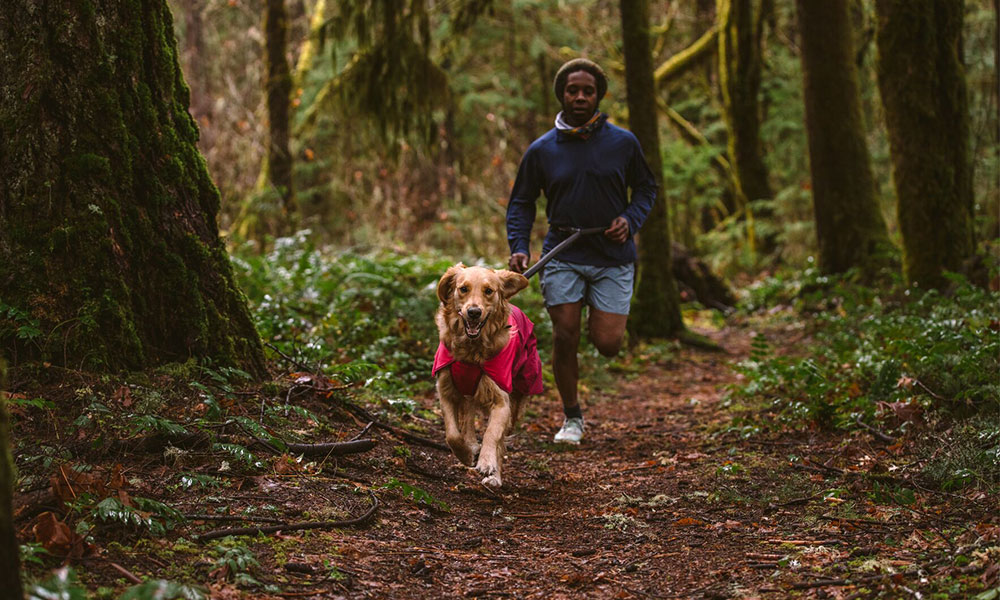
Photo: @Ruffwear
The sport started with mushers training their lead sled dogs when there was no snow. Since then the sport has developed into a recreational and competitive sport. There are now many CaniCross events taking place across Britain. Teach your dog mushers’ commands: “Gee” is go right and “Haw” is left and learn more about the sport here. There’s also CaniBike and CaniScoot too!

Is CaniCross suitable for your dog?
Your dog must be fully grown (at least 12 months old) to start CaniCross but there is no upper age limit as long as your dog is fit and healthy. Care should be taken with brachiocephalic breeds, such as Bulldogs.
Stand-up paddleboarding
Stand Up Paddleboarding (SUP) is one of the fastest-growing watersports – and there’s no reason four-paws can’t join you too. The only skill required of your dog is an ability to sit still, which gets incrementally more important the bigger your dog. The more your dog moves about, the less stable you are.
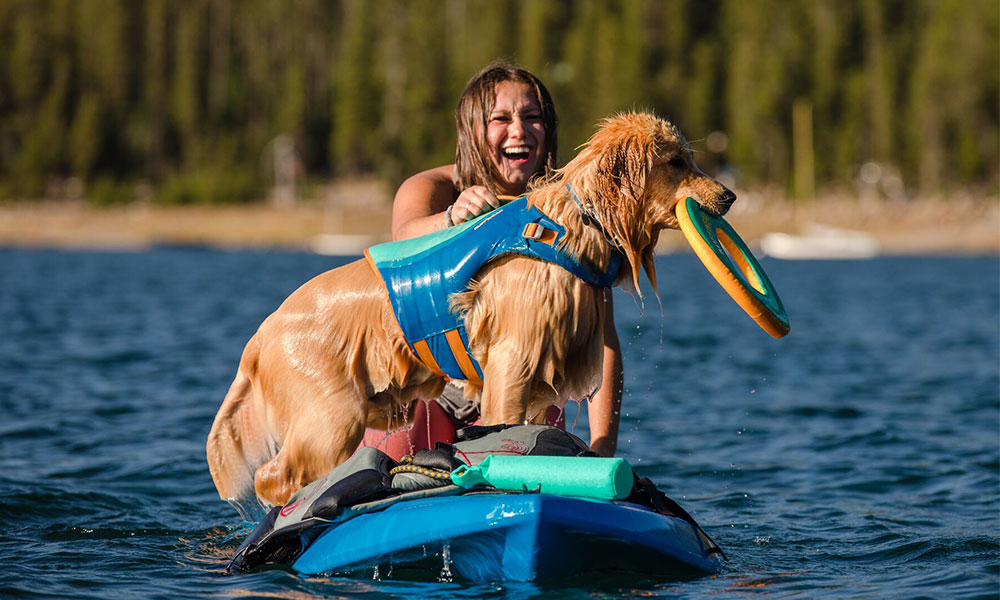
Photo: @Ruffwear
As with swimming, be considerate to others in the water and make sure your dog can follow basic commands. Many stand-up paddleboarding centres offer specific lessons dogs and their owners. This will help them get used to the paddleboard and make sure they don’t keep jumping off (taking you in with them!).

Like a duck to water
Having a dog who loves swimming is not necessarily a good thing as getting them back on board can be a challenge! Never pull by the collar and instead invest in a good harness.
Climbing
Climbing with your dog should only be attempted if your canine friend is well-behaved and relaxed. Set up a small bed for your pooch at the side of the crag so they can sit quietly when needed – make sure this is aware from the rope!
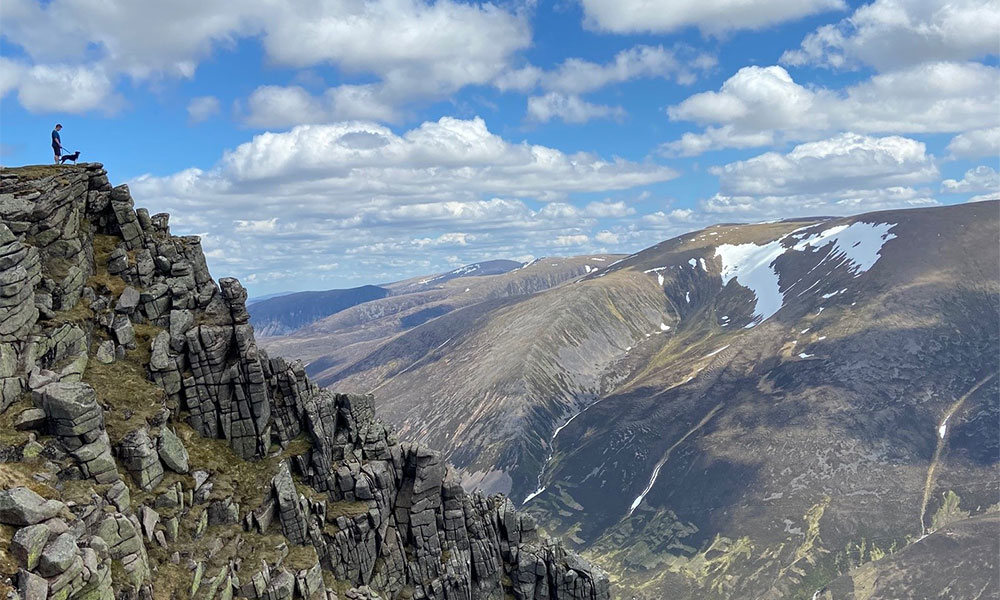
Taking your dog climbing is a great experience and it’s important they have a proper harness and lead to make it safe. Like when learning any new skill with your dog, take it slow, giving lots of breaks. Not all dogs are natural climbers is so important in building the bond of trust between you and your dog and understanding if they feel comfortable at height – watch out for key body language.

Give your dog a job
Make your life easier by letting your dog carry their gear. Climbing already requires a decent amount of kit and there are plenty of specialised harnesses to carry everything your dog will need for a great day on the rocks.
Now you have some ideas on what to do with your four-legged friend and how to do them safely and responsibly, head outside on an epic dog adventure!
Ruffwear offers a full line of innovative Performance Dog Gear® to enhance and inspire exploration for outdoor adventurers and their human companions. They products are built to enhance and assist the interaction between dogs and humans. They are the experts in explore the outdoors with four-legged friends.





